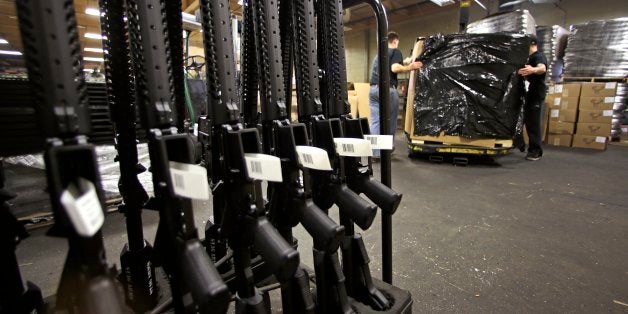
Right after the Sandy Hook massacre, both New York and Connecticut passed laws that tightened up restrictions on owning 'black' guns, a.k.a., the military-style AR rifles like the type Adam Lanza used to kill 26 adults and young kids. The laws basically toughened the earlier assault weapons bans, provoking immediate outcries from the pro-gun gang who challenged the laws based on their inalienable 2nd-Amendment rights. After all, the 2008 Heller decision protected private ownership of all guns that are "in common use," and what could be more common than AR rifles of which probably more than four million have been manufactured over the last twenty years?
The gun industry began promoting black guns in the 1990s when they realized that hunting and traditional sporting use of guns was dying out. This promotion took two forms: on the one hand creating the fiction that black guns, like all guns protected us from crime; on the other hand creating the equally beguiling fiction that military-style weapons were no different from other, traditional rifles since they could only be fired in semi-automatic mode.
The industry went so far as to create an entirely new shooting tradition, replacing the phrase 'assault rifle' with the nomenclature 'modern sporting rifle' so as to pretend that an AR-15 is nothing other than the same, old hunting gun that sportsmen have for generations been taking out to the woods. And for those who like to imagine themselves mowing down ISIS or Al Queda in the streets and alleys of Philadelphia or New York, the guns being sold by Bushmaster, Colt, Stag and other black-gun manufacturers are referred to as 'tactical' weapons, which everyone knows is simply an assault rifle with a different name.
Both the CT and NY laws were challenged and upheld in District Court; now the Court of Appeals, 2nd Circuit, has upheld both laws again. What is interesting about this decision, indeed remarkable, is the fact that it is based not just on the government's authority to regulate guns that are in "common use," but to regulate these particular types of weapons based on their definition as created and promoted by the gun industry itself! The Circuit Court accepted the notion that black guns are just another type of sporting rifle, and it was the acknowledgement that black guns are no different from other types of sporting guns that ultimately legitimized the assault-rifle bans in Connecticut and New York.
Plaintiffs in this case argued that there were more than four million AR-15 rifles owned by civilians and that these guns, like other civilian weapons, could only be fired in semi-automatic mode. As the Court said, "This much is clear: Americans own millions of the firearms that the challenged legislation prohibits." Further, the Court also accepted the notion that many Americans keep an AR-15 in their home for self-defense. Given those circumstances, how could the Circuit Court decide that prohibiting civilian ownership of such weapons was not a violation of 2nd-Amendment rights? Because what the Court did was take the gun industry's own fiction about these guns and stand it on its head.
The industry's marketing of black guns as 'sporting' rifles is based on one thing and one thing only; namely, these weapons can only be shot in semi-auto mode. Never mind that you can deliver up to 60 rounds of ammunition in thirty seconds or less; never mind that the .223 round has a lethality specifically designed to kill or injure human targets; never mind that many military and law enforcement units also deploy the semi-auto gun. That residents in New York and Connecticut can own all kinds of semi-automatic rifles which do not contain certain military-style features means that the ban on AR-style rifles is not a prohibition of semi-automatic weapons at all.
As a noted Supreme Court justice once said, "History also has its claims." And one of those claims is that the 2nd Amendment doesn't give the gun industry the right to invent a tall tale to justify how it tries to sell guns.
